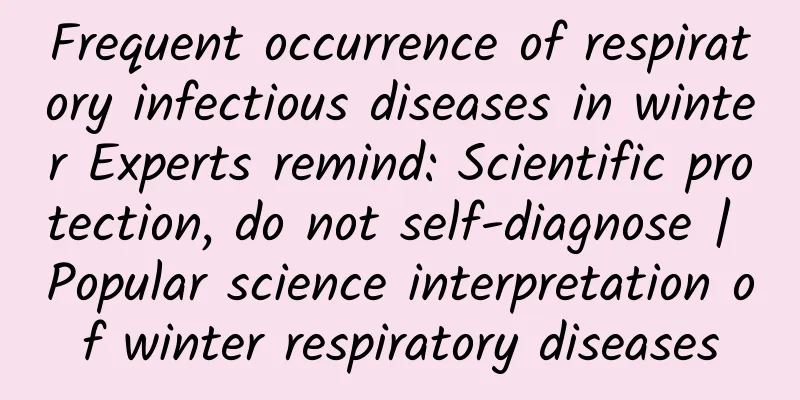Frequent occurrence of respiratory infectious diseases in winter Experts remind: Scientific protection, do not self-diagnose | Popular science interpretation of winter respiratory diseases

|
Editor's note: Recently, Guangming Online's Science Channel and the "Dayi Xiaohu" medical communication think tank launched a special topic called "Winter Respiratory Disease Series Popular Science Interpretations", inviting medical experts to provide popular science interpretations on the causes, transmission routes, prevention measures and treatments of respiratory diseases. Please pay attention. Author: Shi Zhaowen, Department of Respiratory and Critical Care Medicine, Shanghai Pudong Central Hospital Scientific review: Shen Jian, Yueyang Hospital of Integrated Traditional Chinese and Western Medicine, Shanghai University of Traditional Chinese Medicine With the arrival of winter and the roller coaster-like ups and downs of temperatures across the country, various respiratory infectious diseases have frequently appeared on the hot search list. First there were mycoplasma and syncytial virus infections, then there was the rampant influenza virus, and the new coronavirus, which keeps changing its disguise, has also emerged with the JN1 variant. Faced with this grim situation, the China Center for Disease Control and Prevention reminds the public that multiple respiratory infectious agents can cause mixed infection. The National Center for Disease Control and Prevention also reminds that during the upcoming Spring Festival travel season, the number of mobile people will increase significantly, and gatherings such as visiting relatives and friends, traveling, dining, and gatherings will also increase, all of which will increase the risk of respiratory infectious diseases spreading. Recently, the fever clinic and respiratory clinic of the hospital are overcrowded. In order to avoid long waiting time, many patients are unwilling to go out even if they have a "dry fever" at home. Among them, there are some "smart" people who teach themselves medicine and even search for professional knowledge on the Internet for self-diagnosis and treatment. However, when faced with various choices of therapeutic drugs, many people are confused: what pathogen causes my "fever" and "cough"? This confusion has spawned a "new business" - online respiratory sampling and testing. This small sampling box has become a "savior" for many people who are reluctant to go to the hospital. But how reliable is this detection method? Can it really replace the diagnosis of professional medical institutions? These are questions in the minds of many people. Online sampling and testing can provide patients with preliminary screening assistance, but it cannot be used as the basis for a final diagnosis. When conducting sampling and testing, attention should be paid to the professionalism and accuracy of the sampling to avoid false negative and false positive results. As a professional in respiratory and critical care medicine, I have to remind the public a few points: In order to obtain an effective and accurate respiratory pathogen detection report, it is first necessary to collect reliable test samples. Nasopharyngeal swabs and oropharyngeal swabs are two common sampling methods. The nasopharyngeal swab (NPS) for nasal sampling requires the swab stick to be deeply inserted into the nasopharynx to achieve complete and direct contact with the posterior wall of the nasopharynx. The oropharyngeal swab (OPS) for oral sampling samples the tonsils, soft palate, tongue root and posterior pharyngeal wall. Whether it is a nasopharyngeal swab or an oropharyngeal swab, the depth of collection and the length of contact with the mucosa are key factors. If the nasopharyngeal swab is not collected deep into the nasopharyngeal cavity, or the patient's vomiting reaction is large when the oropharyngeal swab is collected, resulting in insufficient sampling time, most of the cells collected may be pathogen-free cells, which may cause "false negatives". In addition, the specimen is also unqualified when the mouth is just rinsed or eaten. Therefore, in order to ensure the accuracy of the test results, the sampling process needs to be carried out by professionals and the sampling must be carried out strictly in accordance with standard operating procedures. For parents, if taking samples from children, they need to be patient and avoid acting rashly to ensure the accuracy of the test results. Jia Congkang, Zhang Shaogang. Application of different respiratory sampling methods in COVID-19 nucleic acid detection[J]. Medical Theory and Practice, 2020, Vol. 33(16):2634-2636. Why do clinicians often recommend retesting or even blood tests in hospitals when you go to see a doctor with an online test report? 70% to 80% of upper respiratory tract infections are caused by viruses, including rhinoviruses, coronaviruses, adenoviruses, influenza and parainfluenza viruses, respiratory syncytial viruses, echoviruses, coxsackieviruses, etc. For bacterial infections of the respiratory tract, common pathogens in adults include Haemophilus influenzae, Streptococcus pneumoniae, Staphylococcus aureus, hemolytic Streptococcus, etc., while the elderly may be infected with Gram-negative bacilli such as Klebsiella pneumoniae. It is obvious that the pathogens covered in the test package are still insufficient. There are popular strains, but it is also easy to cause missed diagnosis of pathogens. Disease diagnosis is often not just about looking at the results of etiology, and sometimes it needs to be combined with other auxiliary tests, such as blood routine, CRP, procalcitonin, etc. Especially when there is a superimposed infection, the doctor will pay more attention to the level of your human white blood cell count, including the level of neutrophils, lymphocytes, and monocytes, which are all directed. Will you fall into misunderstandings if you just "follow the map" to prescribe medicine? Clinical physicians in hospitals have a wealth of diagnostic tools, especially lung imaging manifestations are very meaningful for identifying critically ill patients. Among people with respiratory infections, in addition to upper respiratory tract infections, many patients' infections will spread to the lower respiratory tract, and even cause lung consolidation and induce a series of complications. For elderly patients, their chronic medical history such as COPD, coronary heart disease, and bronchiectasis may induce a major attack and threaten their life safety. At this time, the physician's experience and scientific diagnosis and treatment are particularly important. Physicians need to identify complications such as respiratory failure and heart failure early, especially young patients with acute fulminant myocarditis. At this time, it is far from enough to rely on a pathogen report for diagnosis and treatment. Therefore, when diagnosing respiratory diseases, professional medical institutions should be selected to receive comprehensive and accurate testing and diagnosis to ensure scientific and effective treatment. At the same time, it is recommended to consider the safety of specimens and the privacy protection of personal information. During the collection and transportation of specimens, strict biosafety measures should be taken to ensure that specimens do not cause harm to others or the environment. Don't let measures that are convenient for the public become a "magic box" that delays the disease. |
Recommend
What should I eat to make my cervix open faster? Is there any way to make my cervix open faster?
When giving birth, the mother's cervix will d...
Why do other people have such high Huabei credit limits? What are the tips for increasing Huabei credit limits?
Since opening Huabei on Alipay, many friends have...
Do you need to sober up after drinking liquor? Why do you need to sober up after drinking old liquor?
Liquor is a traditional alcoholic beverage in my ...
Introduction of small methods for girls to treat dysmenorrhea
Dysmenorrhea problems must be treated, but blind ...
What is the reason for not having menstruation without pregnancy? Women should pay attention to it
In addition to pregnancy factors, there are many ...
What if my period stops on the third day?
Nowadays, many women have relatively short menstr...
Do women suffer after having a vasectomy?
With the opening up of the two-child policy, fami...
What are multiple solid nodules in the breast?
There are many types of breast nodules. Different...
Stopping long-term contraceptive pills and not having menstruation
I believe that emergency contraception is a very ...
Unlock winter skin care: five tips to protect the beauty of your skin
Author: Mao Chong Sichuan Provincial People's...
Why is one breast getting bigger?
Regardless of the size of women's breasts, bo...
Early symptoms of pneumoconiosis
Pneumoconiosis is an occupational disease. First ...
What should women drink to nourish their stomachs?
Gastrointestinal diseases are quite common clinic...
What is the difference between bacterial and fungal vaginitis?
There are many types of vaginitis, including bact...
What causes ovarian tumors?
The ovaries are a very important organ in the fem...









